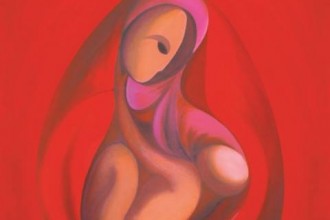Of remembrance.
Vladimir Nabokov, Mary (Mashen’ka), translated by Michael Glenny and Vladimir Nabokov
Vintage International: 1989, 114pages (Paperback)
ISBN: 978-0-679-72620-3
So much of love is memory. Ganin, the protagonist of Nabokov’s first novel, is holed up in Berlin, rhapsodising about a teenage love affair long since recalibrated in ‘the labyrinth of memory.’ Drawing on his own experiences in exile from 1920s Russia, Nabokov sketches a bleak portrait of émigré life: Ganin is ‘mortally depressed’, absorbed in his recollections of Mary to the extent that he becomes ‘unaware of time’. His few, fleeting days with Mary constitute ‘a life that was much more real, much more intense than the life lived by his shadow in Berlin.’
Tellingly, the novel opens with Ganin confined in a broken-down lift with only Alfyorov, his exasperatingly optimistic compatriot, for company. In a twist that seems almost too neat, Ganin discovers that Alfyorov is married to Mary, who is due to arrive in Berlin in six days. Faced with the opportunity to turn fantasy into reality, Ganin plans to meet Mary at the station and elope with her into an impossible future.
In the central plot strands, we see what Nabokov referred to as ‘the beginner’s well-known propensity for obtruding upon his own privacy, by introducing himself… into his first novel’ – the inexperienced writer’s fumbling towards autobiography. Aspects of the relationship between Ganin and Mary mirror Nabokov’s own short-lived dalliance with Lyussya Shulgin, while the sharp dissection of Russian émigré life leans extensively on Nabokov’s time in Berlin. Whether that reliance on what would now be called ‘writing what you know’ should be interpreted as a weakness is open to debate: in his foreword to the English translation of Mary, Nabokov expresses the view that such writing ‘owes less to the attraction of a ready theme than to the relief of getting rid of oneself, before going on to better things.’
The easy assumption that Mary was simply a necessary stepping stone on the way to ‘better things’ displays characteristic false modesty. The final twist –Ganin realising ‘with merciless clarity that his affair with Mary was already over’ –throws the ending wide open enough to demand a second reading, and on closer inspection Mary is as multi-dimensional as Nabokov’s later work. It is laced with nostalgia for ‘old Russia’, with pyrotechnic imagery (rowan trees ‘flame-red with fruit’, a ‘fan of railway tracks’, the ‘translucent nail clipping’ of a new moon), and with a young man’s unique sense of world-weariness.
Above all, Mary is a complex interrogation of love: can we say that love as reality is subordinate to love as idea? In a novel bearing her name, Mary only appears through Ganin’s memories of Russia –he acknowledges that ‘as a living person she was only an uninterrupted continuation of the image which had foreshadowed her.’ Ganin concludes that ‘Other than that image no Mary existed, nor could exist’ –for him, the memories of a few days spent in an ardent adolescent approximation of love supersede any possible adult relationship. Ultimately, the first, fierce love must be enough.
Jacob Silkstone blogs about books and the publishing industry at Alone in Babel. Check it out!




